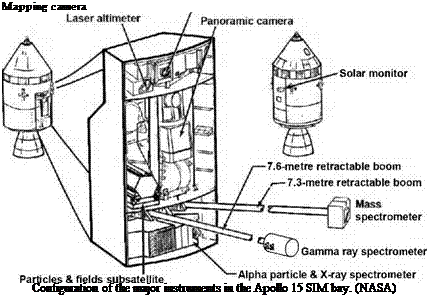SCIENCE STATION IN LUNAR ORBIT
Apollo 13 saw a serious push to use the CSM as an orbiting science platform from which to reconnoitre the lunar surface. The primary tool for this was the Hycon lunar topographic camera: a monster instrument modified from an aerial reconnaissance camera, whose 467-millimetre-focal-length lens peered out through the round hatch window and exposed square 114-millimetre negatives. The Hycon had an unhappy career in Apollo. It lay unused on board the Apollo 13 command module while the crew struggled to reach home after their mission was aborted. It was sent once more on Apollo 14. Once alone in his domain, and having made the circularisation burn to take the Apollo 14 CSM Kitty Hawk into a 110-kilometre orbit, Stu Roosa began a photographic pass that was to have included the Descartes region where scientists were considering sending a future mission. After about 200 exposures, the camera failed, never to work again despite the best troubleshooting efforts of Roosa and mission control.
The SI. VI bay
Lunar science from orbit really got into its stride with the J-missions. just as surface exploration had. In particular, one of the six sectors in the cylindrical service module which had been largely empty on previous missions, gained a bay of instruments and cameras that could be trained on the lunar surface for the five or so days that the CSM spent in orbit. This scientific instrument module, or SIM bay, was operated by the CMP from the time the spacecraft entered orbit until the service module was jettisoned shortly before re-entry.
Each example of the SIM bay that flew carried two cameras: a mapping camera and a panoramic camera, both of which were heavily derived from aerial and space reconnaissance cameras that were classified at the time. Each bay also included a suite of sensors, some of which were deployed out on the ends of retractable booms. These could divine the mineral composition of the lunar soil by sampling its various emissions. On Apollos 15 and 16. a tiny satellite was ejected just before the crew left to come home. It monitored the particles and fields mound the Moon for up to a year.
 |
The full capabilities of the SIM bay were never brought to bear on the whole lunar surface, largely because the CSM’s orbit was defined by the position of the landing site. This limited the reach of the cameras and sensors to a narrow swathe near the equator. At one time, planners had envisioned an I-mission that would have placed a CSM in a polar orbit for a full month, from which its cameras could have imaged the entire surface at a consistent lighting angle, and its remote-sensing instruments could similarly have sampled the entire Moon. With Apollo in its declining years, funds for such a mission were not forthcoming and the scientists had to wait a generation for comprehensive coverage from advanced probes sent by a number of interested nations.










